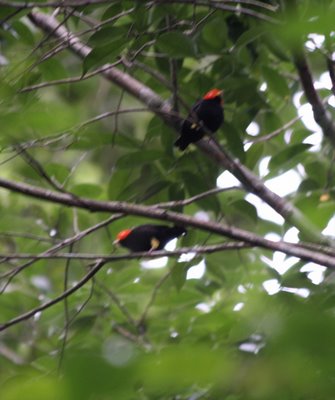
Here are a couple of photos from Tikal, last year, of red-capped manakins dancing. Gotta love those yellow leggings!
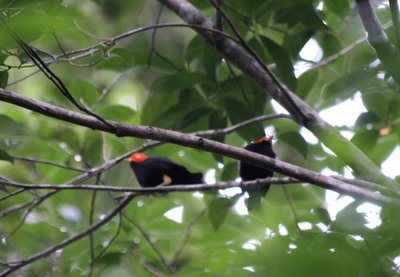
Well, long-tailed manakins have a similarly captivating dance, in which two males cartwheel over each other's backs, boinging up into the air like popcorn, making a kind of wheel of blue, black and red on a horizontal branch deep in the forest. You can watch a video of it here.
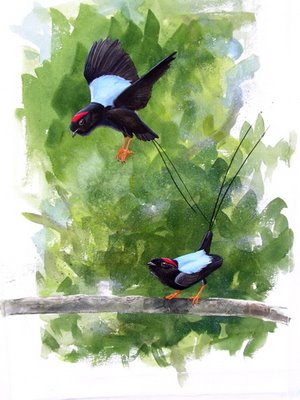
This is my painting of the dance.
Since college, when I spent a great amount of time writing papers that compared the courtship displays of manakins (without ever seeing one!), I've dreamt of spending quality time with manakins. I'd had lousy looks at long-tailed manakins in Costa Rica, and some pretty satisfying experiences watching red-capped manakins both there and in Guatemala. So when Jeff, Liz and Lisa announced their plan to climb Volcan Atitlan to try to see horned guan (did that two years ago, didn't want to do it again),
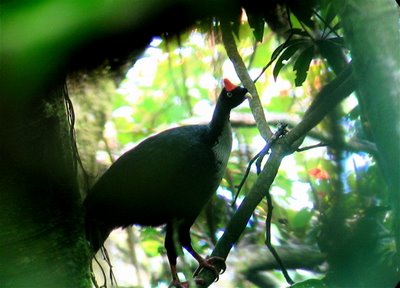 I decided to spend a day with long-tailed manakins. I have to say it was my favorite day in Guatemala, because I like to be alone with birds, and like most artists I crave unstructured time, the chance to soak up a habitat, to hear my own thoughts, to get some feel for what it's like to be a manakin. Dang, I'm glad I have climbed to see the guan though. That is a bird what am a bird.
I decided to spend a day with long-tailed manakins. I have to say it was my favorite day in Guatemala, because I like to be alone with birds, and like most artists I crave unstructured time, the chance to soak up a habitat, to hear my own thoughts, to get some feel for what it's like to be a manakin. Dang, I'm glad I have climbed to see the guan though. That is a bird what am a bird.Manakins are very long-lived birds, and males take at least three years to come into full breeding plumage. Think about it--how many other small passerines stay in immature plumage that long? We're used to such intervals with raptors and gulls, but they're very unusual in tiny birds. This hints at their interesting social system. The plumage of manakins holds many hints to their age, sex and social status. The basic female plumage is an odd, deep bronzy olive. She has elongated central tail feathers, but no red on the head. This is the only female long-tailed manakin I saw all day.
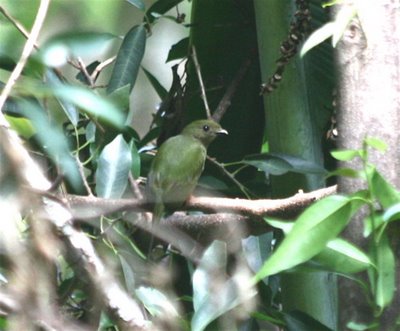 The plumage of young males is similar, except that they show longer central tail feathers and varying amounts of black and red on the head, eventually sporting blue on the back.
The plumage of young males is similar, except that they show longer central tail feathers and varying amounts of black and red on the head, eventually sporting blue on the back.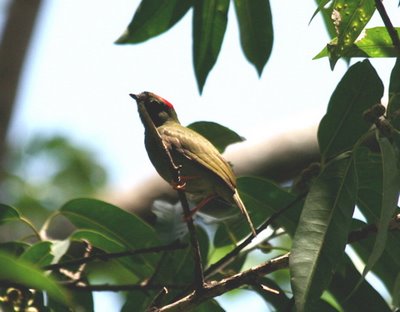
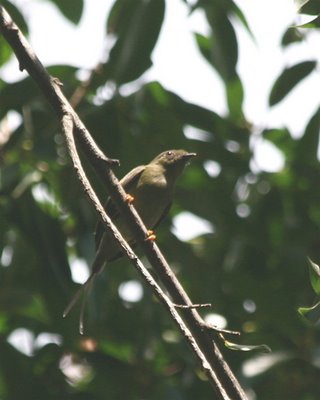 Even once male manakins attain full breeding plumage, the longer they live, the longer their tail feathers grow. So there is a continuum of social signals encoded in the birds' plumage.
Even once male manakins attain full breeding plumage, the longer they live, the longer their tail feathers grow. So there is a continuum of social signals encoded in the birds' plumage.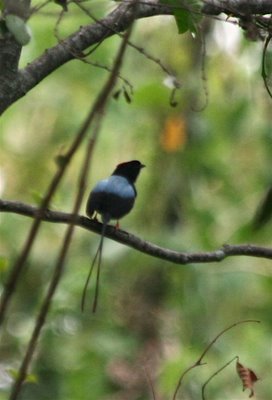 An adult male long-tailed manakin in full breeding plumage. Two words: Just Adorable. Portly, colorful, lively, noisy; just what the doctor ordered for a mind and spirit dulled by the most endless of winters.
An adult male long-tailed manakin in full breeding plumage. Two words: Just Adorable. Portly, colorful, lively, noisy; just what the doctor ordered for a mind and spirit dulled by the most endless of winters.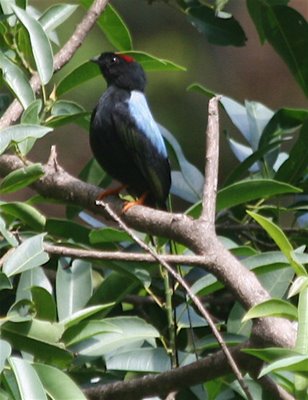
Part of the key to why manakins behave as they do lies in what they eat. They are frugivorous, taking mostly fruit with some insects. They leap and hover, plucking small fruits (they favor lauraceous, or fig, fruits) and insects from branches and leaves. A wide, flat bill and large gape enable them to swallow some pretty outsized fruits. I Can Has Figburger.
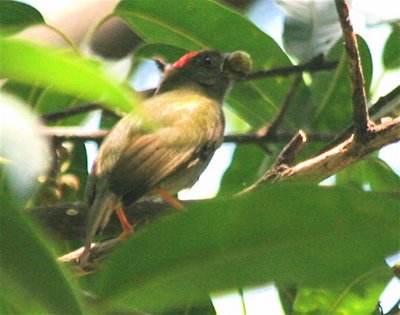
Because their fruit food tends to be abundant and patchily distributed, manakins benefit by hanging out together in loose little flocks. They can all descend on a tree they know to be fruiting without worrying about competing with each other for food. When breeding time comes, long-tailed manakins display together (see the video link, above) in a lek formation, which means that several males get together, partner up, and display within sight or earshot of each other. Female manakins are free to visit the lek and choose which male to mate with based on the splendor of his display. When males display together, this raises all sorts of interesting questions. Which of the partners gets to mate? The older one? The one who dances most vigorously? And where do immature males fit into the picture? It's all up to the females. Ladies' choice. No monogamy, no pairing up; just a quick visit to check out the hombres, pick the best one, mate, and then here comes Ms. Manakin with a baby carriage.
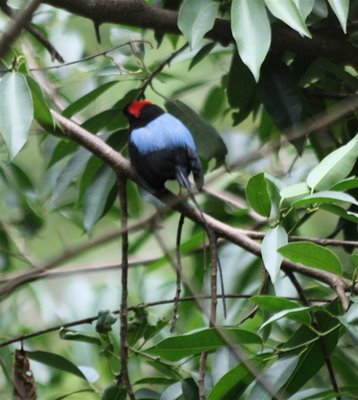 Wearing his sky-blue cape, a manakin shows off his bifurcated crest. Check out the length of his tail! He may well be dominant to a shorter-tailed bird, and more likely to pass his genes along.
Wearing his sky-blue cape, a manakin shows off his bifurcated crest. Check out the length of his tail! He may well be dominant to a shorter-tailed bird, and more likely to pass his genes along.Because there are so many egg predators in tropical forests, the female manakin lays only two eggs a year, in a shallow cup suspended by its rim from a horizontal fork of a limb at about eye level in the understory. She builds the nest, incubates the eggs and raises the young all by herself. A gaudy male would be no help in such a predator-rich setting. It may take a female her entire 20-year-plus lifespan to replace herself; it may take a young male manakin years of understudy at the lek to attain his right to mate. This is part of what's so fascinating about tropical birds; they often operate on entirely different time frames and feeding regimes, with much higher site fidelity, than our more fecund, ephemeral, migratory temperate birds.
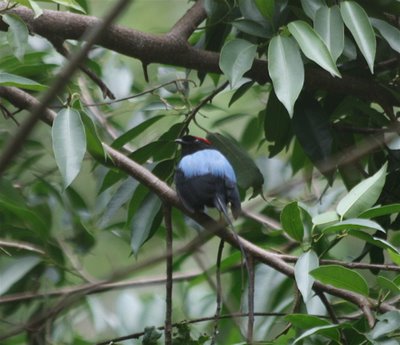 All these questions and more swirled about my head as I spent the day watching and photographing long-tailed manakins. As I prepared to leave, the nasal nyaaaah! and hauntingly rich whistle--t0-LE-do! of displaying long-tailed manakins chimed from a brushy hillside above me. It was impossible to see more than a glimpse of the dancing birds, but knowing they were dancing, finally hearing the song I'd read about for years, filled me with joy. The air was warm, bird song rang out all around me, a few blackflies buzzed, and I stayed and listened and smiled, immersed in the peace of being among wild things.
All these questions and more swirled about my head as I spent the day watching and photographing long-tailed manakins. As I prepared to leave, the nasal nyaaaah! and hauntingly rich whistle--t0-LE-do! of displaying long-tailed manakins chimed from a brushy hillside above me. It was impossible to see more than a glimpse of the dancing birds, but knowing they were dancing, finally hearing the song I'd read about for years, filled me with joy. The air was warm, bird song rang out all around me, a few blackflies buzzed, and I stayed and listened and smiled, immersed in the peace of being among wild things.Have a lovely Easter. I've been in town all afternoon, being a bunny.






21 comments:
Your drawings always have so much life in them. What an amazing talent for capturing a bird's personality!
And as for the guan -- that's one swell hat.
Dancing manakins are almost as good as orgling alpacas. This was terrific!
Julie,
I know that feeling of joy that claimed you in that moment of immersion.
Only alone - and only in nature.
Your painting is well . . just right.
Made me smile.
Frugivorous!! That's a life word for me!
I thought the red-capped manakin was cool but the video and photos of the long-tailed manakin are amazing. When you said that the male's tails grow longer with age, it made me think of a question that's been rolling around in my head for a while-
Do birds periodically molt ALL of their feathers? Do these male manakins only have their long tails during the breeding season? IS there a breeding season in tropical areas where it's warm and there is pleantiful food all year round? Will winter ever end?
Dear Lynne,
Great questions, all! Yes, most birds periodically molt all their feathers. I'm wondering the exact same thing about the manakin tails--you'd think that it would be counterproductive to molt the really long ones, especially if they're a status symbol. Perhaps everything BUT the middle two rectrices fall out, and those just keep growing--that's the best guess I have. I don't know the real answer to that, but I know someone who does (the owner of the painting, in fact), and will try to find out.
As far as seasons in the tropics, yes, there are definite seasons, but they're tied more to moisture than temperature. They're also linked to fruiting times of various plants. It was the very beginning of the breeding season in Guatemala in late February for manakins.
As far as winter ever ending up here in the temperate zone, the only answer I've been able to discern, given that we've had one day of sunshine in the past week, and are due for more rain all weekend, is...nope. The woodcocks and phoebes have much more faith than I. They're going about their bidness.
Fantastic post. We're glad you had some alone with nature time, something we all want and some of us require. Great photos and drawing.
I hope we will see a photo of you as a bunny. Or were you speaking rhetorically?
Red Sox fans and Yankee fans ain't got nothin' on Manakin fans. Your enthusiasm just beams off the computer screen!
What a great story. The video of the boinging is odd, interesting and kind of cute! For you, being immersed in their nature and smiling - what a wonderful feeling.. Your painting is the highlight of this post, ya know.
You said, "Ms. Manakin with a baby carriage." LOL! What determines a female's attraction to the male? My guess is Chemistry baby, the gleam in the eye. A wink.
You know, your description of manakin plumage and behavior sounds a lot like that of birds-of-paradise: Outlandish feathers and males desperately displaying for plain but discriminating females. Is the manakin a New World relative of theirs?
The en masse descent on a fruiting plant also has parallels to our cedar waxwings and robins. Isn't it neat how behaviors in one niche are mirrored in another?
Love the manakin story. It explains the quick view I had of another post that began "after I studied manakins" or something like that, a post which disappeared as quickly as it appeared. Storing things up in the larder, Oh Great-Grasshopper Blogger? (wink!)
~kathi
Oh, PS: In reference to the long-tailed's feathers getting longer with age: In deer, the antlers are shed and replaced each year by larger antlers with more points. Couldn't the long tail feathers be molted and replaced by longer feathers? Yes, it is energy-expensive, but whatever it takes to be the biggest, baddest boy at the lek ...
~KD
Those are fascinating little birds. It is amazing how different their behaviors are from birds here. The colors are spectacular. You'd think the competing males would try and pull one another's tails...lol!
When I scrolled across the first 2 photos, my immediate thought was, "what a lovely subject that would be for a watercolor--the spots of light through the leaves so striking"
Yay--it's lovely!
Such a sweet remembrance of the fullness nature can provide for those spending time there.
Dear folks,
Well, first, Katdoc, manakins are related to cotingas, all of them being sort of vaguely related to flycatchers. They're Neotropical specialties, and weirdness goes with the taxon. I still don't know about molt in their tail feathers, but I've sent an inquiry out.
I did a little digging today and found an 8-year study whose results were summarized thus:
Only 16 of 142 (8%) banded males copulated during an 8-year period. The mean estimated age of male copulators was 10.1 years (SD = 2.2), and only 5 of 166 copulations were by males less than 8 years old. Females probably begin reproduction at age 1 or 2.
Another study stated that cooperatively-breeding male manakins were not necessarily related. Even though only the alpha male gets to mate, benefits accrued to the subordinate males (who participate in the displays with the alpha) because they afforded betas rare chances to mate. Consistent displays also kept females coming to the leks, which eventually (10 years later??) might afford betas a chance to climb the alpha throne and get a mating in.
Reading this made me wonder about it all. It just seems like such a slim and delayed payoff for expending all that energy. How did such a mating system evolve?
Are there outlaw manakin rapists out there? It made me wonder if subordinate males keep displaying with the alpha year after year because it's FUN. It sure looks fun. I know, I'm being flip. But jeez!! How many human males would go out on double dates with a more popular friend, if they got lucky maybe once, ten years later?
Another way to look at it is that subordinate males are kind of stuck in the only mating system they've got. Hmmm. Much to ponder.
Beautiful post! The thought of you being a bunny made me smile.
STOP IT - you're KILLING me! It was bad enough that one of this week's episodes of Sunrise Earth on Animal Planet was broadcast from Tikal AND that you and Bill have been blogging on your trip - you've got to go and bring up MANAKINS. It's just not FAIR...
One little correction: Like female hummingbirds, female manakins do lay two eggs per clutch but may nest several times per year. They have to, because even their decade-plus lifespan couldn't compensate for their extremely low rate of nesting success. A cool thing about some manakins' nests (including the White-collared that I studied many moons ago) is that they're loosely woven from water-repellent stems - you can see right through the bottom. The eggs don't really need insulation, but they do need to keep from drowning in those frequent tropical downpours during Mom's frequent absences. --SW
Woo, thanks, Sherri! Unlike many Web-based pontificators (and I count myself among the worst) I love to be corrected. So if female manakins nest several times a year, maybe there's a little more nookie going on for the subordinate males than researchers know about...
and thanks for the nest details. Cool.
So, can you enlighten me on central rextrix molt in male LT manakins?
Got lousy looks at white-collared this time, but did see one doing his zipbang hopping against a sapling, now that was fabulous.
Sorry to torture you. Know that we suffered for this trip! Best to Tom.
Superb images Julie.
By the way, you've been tagged with the Six Word Memior Meme: http://www.bornagainbirdwatcher.com/2008/03/my-life-in-six-words.html
Of the members of the manakin family, I've only seen the Orange-crowned. On my one and only trip to the tropics (so far!) I was really bummed to miss the Red-capped. They are cool birds, but in all honesty it's because red and black are my favorite colors. But it looks like there's another species that goes on my must-see list!
Thanks for the great post.
You wrote: Unlike many Web-based pontificators (and I count myself among the worst) I love to be corrected.
That's just one more thing that ranks you among the best, Zick!
Unfortunately, I don't have intimate knowledge of any of the fancy-tailed manakins. I can tell you a bit about the development of sound-producing primary attenuation in M. manacus and M. candei, but that's as deep as I ever got. I've just always assumed that the Long-taileds molted the central pair every year and grew a new, longer set.
BTW, after listening to your latest NPR gig, Tom told me how grateful he was that we don't have a macaw in the family. ("Or an amazon," I added.)
Hi, John, and thanks for tagging me for the meme.
Slob blogger; never passes memes along
is the first six-word summation that comes to mind. The second is:
So much to be thankful for.
How beautiful! Your painting is amazing!
I get really excited when I find birds dancing, jumping, displaying themselves for the partner (or partner to be!), it's always unique.
Post a Comment